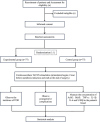Effects of transcutaneous auricular vagus nerve stimulation on postoperative delirium in older patients with hip fracture: protocol for a randomised controlled trial
- PMID: 39979049
- PMCID: PMC11843011
- DOI: 10.1136/bmjopen-2024-092413
Effects of transcutaneous auricular vagus nerve stimulation on postoperative delirium in older patients with hip fracture: protocol for a randomised controlled trial
Abstract
Background: Postoperative delirium (POD) is an acute neurocognitive impairment and is commonly observed in older patients with hip fractures. POD is associated with poor outcomes, including increased postoperative complications, prolonged hospitalisation, high costs and increased perioperative mortality. Therefore, reducing the occurrence of POD and improving cognitive abilities in older patients are critical and urgent. Transcutaneous auricular vagus nerve stimulation (TAVNS) is a simple, safe, non-invasive treatment and has great potential to improve cognitive function. This clinical study will evaluate the effectiveness of TAVNS in reducing the incidence of POD in older patients and further elucidate the possible underlying mechanisms.
Methods and analysis: This randomised, double-blind, single-centre controlled trial will enroll 154 older patients undergoing hip fracture surgery, who will be randomly assigned to the TAVNS group (n=77), receiving TAVNS from 1 hour before anaesthetic induction to the end of the surgery, or the sham stimulation group (n=77), receiving sham stimulation in the same manner. The primary outcome measure will be the incidence of POD during the first 7 days post-surgery, as assessed by the confusion assessment method for the intensive care unit. The secondary outcomes include the incidence of delayed neurocognitive recovery; serum acetylcholinesterase and butyrylcholinesterase levels; the concentrations of tumour necrosis factor-α, interleukin-1β, interleukin-6 and S100β; unplanned intensive care unit admission rates; the length and cost of hospital stay; the incidence of postoperative complications during hospitalisation; and mortality at 1 month, 6 months and 1 year after surgery.
Ethics and dissemination: This study was approved by the Ethics Committee of the Chongqing Traditional Chinese Medicine Hospital on 15 May 2024 (2024-KY-HY-13). The findings will be published in the international peer-reviewed academic journals and presented orally at academic conferences.
Trial registration number: ChiCTR2400085508.
Keywords: Aged; Electric Stimulation Therapy; Postoperative Delirium.
© Author(s) (or their employer(s)) 2025. Re-use permitted under CC BY-NC. No commercial re-use. See rights and permissions. Published by BMJ Group.
Conflict of interest statement
Competing interests: None declared.
Figures


References
Publication types
MeSH terms
Substances
LinkOut - more resources
Full Text Sources
Medical
